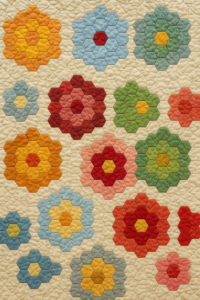
The quilting tradition is full of iconic patterns that have crossed generations, carrying stories, memories, and emotions stitched into every seam. Among them, Grandmother’s Flower Garden holds a special place. This classic quilt pattern, known for its colorful hexagonal flowers arranged like blooming gardens, has become a symbol of craftsmanship, patience, and the delicate beauty that quilting represents.
The name Grandmother’s Flower Garden is not only a reference to its floral aesthetic but also to the feeling of affection and coziness it evokes. Many quilts in this style were made to warm families, decorate homes, and, above all, transmit love. To this day, this pattern continues to enchant artisans, collectors, and sewing enthusiasts around the world.
In this article, we will explore the origin of the Grandmother’s Flower Garden, its unique features, the meanings behind its design, and why it remains one of the most beloved patterns in the quilting universe.
The Grandmother’s Flower Garden pattern dates back to the 19th century, although it became especially popular during the Great Depression in the United States in the 1930s. At that time, when many families needed to reuse fabrics, the technique of creating flowers with small hexagons became practical, creative, and accessible.
Women often used scraps of old clothing, leftover fabrics, or even printed flour sacks to piece together their flower gardens. The result was vibrant quilts, filled with colors and varied patterns, turning necessity into art. By stitching hexagon after hexagon, they created flowers that resembled small flower beds, forming a true fabric garden.
Beyond its aesthetic appeal, the Grandmother’s Flower Garden also carried symbolic value. Each piece represented unity, resilience, and hope during difficult times. The act of quilting became a moment of community and sharing among families and neighbors, producing quilts that were treasured for generations.
The main feature of the Grandmother’s Flower Garden is its use of hexagons. This geometric shape, when arranged strategically, creates flowers with six petals surrounding a central hexagon, forming blocks that resemble stylized blossoms. When multiple flowers are pieced together, the illusion of a colorful, endless garden emerges.
Traditionally, each flower consists of:
A central hexagon, often in a contrasting color;
Petals, formed by six hexagons arranged around the center;
An outer ring of hexagons, which may be in neutral shades or varied tones.
The background is usually made in white, cream, or light colors to highlight the vivid flowers. However, modern versions often use contemporary palettes, including pastel tones, monochromatic schemes, or bold combinations to reinvent the classic style.
Another important aspect is the technique used. The Grandmother’s Flower Garden is often made with the English Paper Piecing (EPP) method, where small paper hexagon templates are used to ensure precision in cutting and stitching. This process requires patience and attention to detail but results in flawless finishes.
The Grandmother’s Flower Garden is more than just a beautiful quilt pattern; it holds deep symbolism that makes it especially meaningful for both the maker and the recipient.
The flowers represent life, renewal, and joy, and when transformed into fabric, they evoke the sense of an eternal garden that never fades. The fact that each flower is made from different fabrics also symbolizes diversity and unity: distinct pieces come together to form something greater, beautiful, and harmonious.
Another charming aspect is the emotional connection tied to this pattern. Many people remember their grandmothers or mothers quilting this design, reinforcing the idea of cultural and family heritage. Owning a Grandmother’s Flower Garden quilt feels like preserving a piece of family history, full of love and tradition.
Today, this pattern is also associated with sustainability and mindful living. Reusing fabrics, valuing handmade work, and dedicating time to creating something lasting align perfectly with modern movements such as slow fashion and conscious consumption.
Despite its historical roots, the Grandmother’s Flower Garden remains highly relevant today. Modern quilters have reinvented the pattern, using new color schemes, innovative fabrics, and even graphic combinations that give the classic a contemporary twist.
Nowadays, variations of this pattern can be found in items beyond quilts, such as:
Decorative pillows;
Handmade rugs;
Wall hangings;
Bags and accessories;
Clothing with patchwork details.
step by step Grandmother’s Flower Garden
What keeps the Grandmother’s Flower Garden alive is precisely its versatility and its ability to adapt to different styles. It can be romantic and delicate when made with soft tones, or bold and modern when crafted with strong, contrasting colors.
In addition, quilting communities worldwide continue to share tutorials, tips, and inspiration, keeping the tradition alive and encouraging new generations to explore the technique.
The Grandmother’s Flower Garden is much more than a quilt pattern. It is a symbol of resilience, love, and tradition, capable of connecting generations through handmade artistry. Its fabric flowers represent stories and memories stitched with patience and dedication, transforming simple scraps into true works of art.
By choosing or creating a quilt in this style, you not only bring beauty into your home but also connect with a rich, timeless cultural heritage. The Grandmother’s Flower Garden is an invitation to cultivate a garden of flowers that never fades, preserving the delicacy of the past while renewing it in the present.
